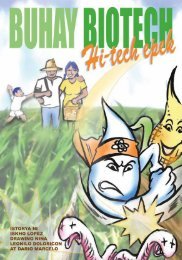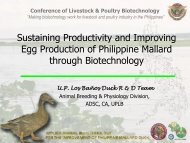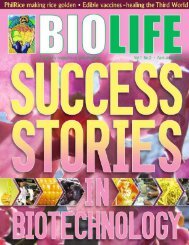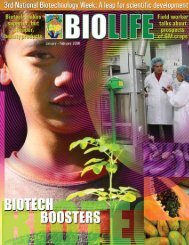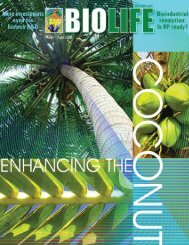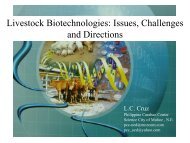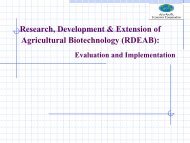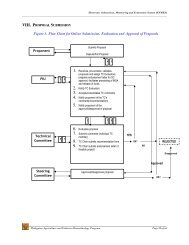Download PDF - SEARCA Biotechnology Information Center
Download PDF - SEARCA Biotechnology Information Center
Download PDF - SEARCA Biotechnology Information Center
Create successful ePaper yourself
Turn your PDF publications into a flip-book with our unique Google optimized e-Paper software.
January – March 2005 BIO LIFE<br />
15<br />
spraying in the first 40 days after sowing<br />
rice is a waste of money and a threat to<br />
farmers’ health and the environment.<br />
Through communication campaign,<br />
using radio dramas, leaflets, posters and<br />
billboards, researchers persuaded almost<br />
2 million rice-growing households in the<br />
Mekong Delta to spray much less.<br />
Surveys in 1999 showed insecticide<br />
use had halved from an average of 3.4<br />
applications per farmer per season to 1.7<br />
applications. The percentage of farmers<br />
who believed that insecticides bring higher<br />
yield had plunged from 83 to 13 percent,<br />
and those who realized that insecticides<br />
killed the natural enemies of rice pests had<br />
risen from 29 to 79 percent, IRRI said.<br />
In Bangladesh, the success story in<br />
reducing chemical use in rice farming<br />
came after three years of the IRRI-led<br />
project called Livelihood Improvement<br />
Through Ecology (LITE), where more<br />
than 2,000 farmers have reduced their<br />
insecticide use by 99 percent. Before the<br />
project, high government subsidies on<br />
insecticides got farmers hooked on<br />
spraying. With continued donor support<br />
for the project, the next decade may see<br />
insecticide use disappear among the 11.8<br />
million rice farmers of Bangladesh.<br />
The challenge for farmers in the use of<br />
chemical fertilizers has always been when to<br />
apply them and how much. After about 10<br />
years of development and study, IRRI is<br />
promoting a simple site-specific nutrient<br />
management (SSNM) technique by which<br />
farmers feed the rice plant nutrients only<br />
as and when needed, when nutrients in<br />
indigenous sources—soil, water, crop<br />
residues and manure—are less than optimal.<br />
As the two SSNM sites in Bangladesh<br />
showed, net return with real-time nitrogen<br />
management, compared with that of the<br />
farmers’ practice, was on average US$41<br />
to US$65 per hectare better for each<br />
season—across five seasons, IRRI said.<br />
The benefits from SSNM multiply when<br />
improved management of phosphorus and<br />
potassium is included.<br />
SSNM is currently being evaluated by<br />
extension workers and farmers at some 20<br />
locations in Bangladesh, China, India,<br />
Indonesia, Burma, Thailand, the Philippines<br />
and Vietnam. Each location represents<br />
an area of intensive rice farming on<br />
more than 100,000 hectares with similar<br />
soils and cropping systems, it added.<br />
“And so, as farmers across the riceproducing<br />
world join us in the doubly green<br />
revolution,” Cantrell said, “we are confident<br />
that food security will improve significantly<br />
for millions of impoverished people.”<br />
The emerging<br />
job provider<br />
THE predicament of the present<br />
gov-ernment is how to address its<br />
job crisis at the same time compete in<br />
the global economic arena. Its economic<br />
policy must coincide with its social<br />
and political agenda. Programs and<br />
policies to solve the unemployment<br />
problem must be politically sensitive.<br />
Their implementation must cushion<br />
the undesirable impact on<br />
marginalized sector. Investments<br />
sourced locally or overseas must have<br />
strong employment orientation and<br />
work-force-biased.<br />
One such area which have high potentials<br />
to provide job opportunities is<br />
biotechnology-based industries. Referred<br />
to as entrepreneurial life science<br />
sector by an international accounting<br />
firm, Ernest and Young, biotechnology<br />
industry offers windows of opportunities<br />
for employment. While its applications<br />
which involve the use of modern<br />
scientific techniques to produce or develop<br />
products and services have encountered<br />
resistance and consumer distrust,<br />
biotechnology will certainly become<br />
a strategic employment generator.<br />
In north American and European<br />
countries, biotechnology industry has<br />
significantly provided jobs for thousands<br />
of workers. As a multibillion<br />
dollar industry in the US biotech companies<br />
which invested about $10 billion<br />
in research and development were<br />
reported to have already provided jobs<br />
to more than 200,000 persons. Other<br />
companies in Canada and Europe have<br />
similarly accounted for increased job<br />
opportunities in these areas.<br />
As a result of scientifically and financially<br />
successful applications in<br />
health and environment, investors<br />
have shifted their funds to biotechbased<br />
businesses. In the health sector,<br />
about a hundred biotechnology drugs<br />
are expected to be in the market. More<br />
companies are reported to be involved<br />
in agro-food business. Applications of<br />
modern biotechnology to crops and<br />
to the conservation of food have been<br />
advancing rapidly. Environmental degradation<br />
and climate change have pro-<br />
Joe Escartin<br />
vided added impetus for the adoption<br />
of biotechnology, particularly GMOs<br />
in agri-based industry. Certainly concern<br />
for food security will make the<br />
advent of biotechnology inevitable.<br />
Being a knowledge-intensive industry,<br />
biotechnology will bring about expansion<br />
in research and development activities<br />
of companies as their competitive<br />
edge. Investments in the intellectual<br />
capital of companies will usher a bright<br />
prospects for employment for the Filipino<br />
knowledge-based workforce.<br />
Manufacturing industries for materials<br />
such as biodegradable plastics,<br />
biopolymers and biopesticides, novel<br />
fibers and timbers are potential employment<br />
generators. With its contributions<br />
to industrial processes, food<br />
production and storage as well as<br />
drugs; safe health and environment,<br />
biotechnology will become the business<br />
of the future. It will be a significant<br />
jobs provider for many of our<br />
graduates of science-based courses.<br />
As we welcome the advent of biotechnology<br />
as potential provider of job<br />
opportunities for our knowledgebased<br />
workers, we cannot disregard<br />
some apprehensions and distrusts of<br />
some sectors. Unease about health and<br />
safety is very prominent. One of the<br />
reasons for the public unease is the<br />
genetically modified foods and crops.<br />
For instance, it is feared that antibiotic<br />
resistant genes inserted in genetically<br />
modified plants for monitoring<br />
purposes may spread to humans.<br />
Also, the so called “super weeds”<br />
due to possible leak out of genes put<br />
into plant to make them resistant to<br />
disease and pests may cause<br />
Turn to page 29




